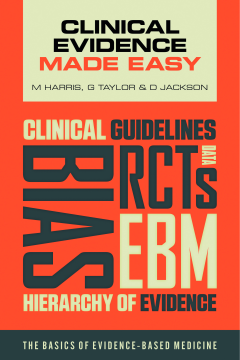
Additional Information
Book Details
Abstract
Clinical Evidence Made Easy scores maximum 100 and 5 stars on Doody's (Sept 2014)! Here's what the reviewer said:
"This is one of a number of basic science books on evidence-based medicine and a very good addition to the library. The authors present the concepts in a unique and simple way that is easy to read and understand."
Clinical Evidence Made
Easy is a concise and
accessible introduction for any healthcare professional looking to understand
clinical data sources.
As clinical evidence becomes increasingly important in healthcare it is vital
that healthcare professionals can read, analyse and understand the clinical
data being presented. This book will equip the reader with the core skills and
knowledge to make sense of the clinical evidence, without over-burdening them
with information and jargon.
Building on the success
of the other ‘Made Easy’ books (Medical Statistics Made Easy, Healthcare
Economics Made Easy, Practice Accounts Made Easy), this is a book for
non-specialists who need knowledge of the key tools and techniques so they can
understand the clinical data, but who have no need to become experts in the
subject.
Clinical Evidence Made Easy will enable healthcare workers in all fields to understand and implement the results from clinical trials, clinical journals and other data sources with confidence.
"The chapters are succinct. The text is simple and easy to follow........I really like this text. The title says it all - Clinical Evidence Made Easy."
"...the book will be useful for anyone who is interested in evidence based practice and who wants to be able to read published research papers and to pose appropriate questions of them."
Table of Contents
| Section Title | Page | Action | Price |
|---|---|---|---|
| Foreword | vii | ||
| Preface | viii | ||
| About the authors | ix | ||
| Acknowledgements | ix | ||
| How to use this book | x | ||
| Abbreviations | xii | ||
| 1 The importance of clinical evidence | 2 | ||
| 2 Asking the right questions | 7 | ||
| 3 Looking for evidence | 11 | ||
| 4 Choosing and reading a paper | 17 | ||
| 5 Recognizing bias | 23 | ||
| 6 Statistics that describe | 29 | ||
| 7 Statistics that predict | 37 | ||
| 8 Randomized controlled trials | 45 | ||
| 9 Cohort studies | 53 | ||
| 10 Case-control studues | 58 | ||
| 11 Research on diagnostic tests | 64 | ||
| 12 Qualitative research | 72 | ||
| 13 Research that summarizes other research | 80 | ||
| 14 Clinical guidelines | 91 | ||
| 15 Health economic evidence | 98 | ||
| 16 Evidence from pharmaceutical companies | 111 | ||
| 17 Applying the evidence in real life | 115 | ||
| 18 Asking the right questions | 122 | ||
| 19 Choosing the right statistical test | 127 | ||
| 20 Randomized controlled trials | 133 | ||
| 21 Cohort studies | 141 | ||
| 22 Case–control studies | 150 | ||
| 23 Research on diagnostic tests | 157 | ||
| 24 Qualitative research | 164 | ||
| 25 Research that summarizes other research | 173 | ||
| 26 Clinical guidelines | 183 | ||
| 27 Health economic evidence | 192 | ||
| 28 Evidence from pharmaceutical companies | 200 | ||
| 29 Putting it all together… | 206 | ||
| Index | 208 |
